Chinese Visa Guide For Indian Citizens: Requirements, Process & Tips
As of 2025, there is still no India-wide Chinese visa-free policy. Most Indian citizens must apply for a visa to enter China, although limited visa-free transit options are available. This article will explain the basics of applying for a Chinese visa from India.
Table of contents
- China visa types for Indian citizens
- Transit visa rules for Indians
- Documents needed to apply for a China visa
- China visa application photo requirements
- Submitting your Chinese visa application in India
- China visa fees for Indian citizens
China visa types for Indian citizens
Before applying, determine your visa type based on your travel purpose. The main categories of Chinese Ordinary visas are as follows:
- Tourist (L): For travel and sightseeing. Usually issued for single or multiple entries, with stays of 30–90 days.
- Business (M): For business activities such as trade fairs, meetings, and negotiations. Requires an official invitation letter from a Chinese company or organization.
- Study (X1/X2): X1 is for students studying in China for more than 180 days; X2 is for short-term study (less than 180 days). Admission notice and JW201/JW202 form are required.
- Work (Z): For foreigners taking up employment in China. Requires a work permit notice or employment license issued by Chinese authorities.
- Transit (G): For travelers transiting through China to a third country. Usually short-term, and sometimes replaced by visa-free transit policies in certain cities.
- Family Reunion (Q1/Q2): Q1 is for family members of Chinese citizens or permanent residents staying in China long-term; Q2 is for short-term visits (e.g., up to 180 days).
- Private Visit (S1/S2): S1 is for family members of foreigners working or studying in China (longer stays over 180 days); S2 is for short-term visits.
- Talent (R): For high-level professionals and urgently needed specialists. Provides more flexible entry conditions.
- Crew (C): For international airline, train, and ship crew members, and their accompanying family members.
- Permanent Resident (D): For foreigners intending to reside in China permanently. Rarely issued and requires strict qualification checks.
- Journalist (J1/J2): J1 is for resident foreign correspondents staying long-term; J2 is for short-term reporting assignments.
Note: China will also introduce a new K visa in October 2025 for young professionals in science and technology, further expanding entry options for specialized talent.
Transit visa-free rules for Indians
Indian citizens are eligible for several types of visa-free transit when passing through China under specific conditions:
- 24-Hour Transit Without Visa (TWOV): If you're transiting through China—by air, train, or cruise—to a third country and will leave within 24 hours, you generally do not need a transit visa. This is allowed at most airports and major border ports. Conditions include a passport valid for at least 3 months and confirmed onward tickets. This exemption is widely available, with no visa fee required.:contentReference[oaicite:1]{index=1}
- 240-Hour (10-Day) Visa-Free Transit: This extended transit option is available for holders of passports from a select list of countries—but Indian citizens are not eligible unless India is officially added to the list. As of 2025, eligibility remains limited to nationals of 55 countries (such as the U.S., U.K., Russia, Japan, Australia, and many European countries).:contentReference[oaicite:2]{index=2}
To use either Chinese visa-free transit option, you must be continuing your journey onward to a third country. If you attempt entry without meeting the conditions (e.g., not continuing to another country), it may be considered illegal entry.
Documents needed to apply for a China visa
The basic requirements for all visa types
Whichever visa type you apply for, you will need:
- An application form. In this article, we provide the guidelines on filling out the form ;
- A photo compliant visa Chinese visa picture requirements;
- Your original passport with at least two blank visa pages and at least six months of remaining validity;
- A photocopy of the passport’s data page and the photo page if it is separate.
In the following points, we’ll list the required documents for the most popular kinds of Chinese visas.
Tourist Visa (L)
You will need to provide a round-trip ticket booking record and proof of a hotel reservation or an invitation letter issued by a relevant entity or individual in China with the following information:
- Travel itinerary: dates of arrival and departure, places of visit, relations between the tourist and the inviting party, proofs of sufficient funds, etc.;
- Information on the inviting party (entity or individual): name, contact number, address, official stamp, a signature of the legal representative or the inviting person.
Business Visa (M)
You will need documents on the commercial activity issued by a trade partner in China, trade fair invitation or other invitation letters issued by a relevant entity or individual. The invitation letter should contain the same information as described above for a tourist visa.
Noncommercial Visit Visa (F)
Provide an invitation letter issued by a relevant entity or individual in China, with details as described above for a tourist visa.
Student Visa (X)
Submit original and photocopy of the Admission Letter issued by a school or other entities in the PRC.
For an X1 visa with an intended stay of more than six months, applicants should also provide an Original and a photocopy of “Visa Application for Study in China” (Form JW201 or Form JW202).
Work/ Employment Visa (Z)
One of the following work permits is required:
- Foreigners Employment Permit issued by the Ministry of Human Resources and Social Security of the PRC;
- Registration Certificate of Resident Representative Offices of enterprises of foreign countries (regions) issued by Chinese authorities of industrial and commercial administration;
- An approval document for commercial performances issued by the Chinese government authorities for cultural affairs;
- Invitation Letter to Foreigners for Offshore Petroleum Operations issued by National Offshore Oil Corporation.
China visa application photo requirements
The photo you use for the application form has to fulfil the following requirements:
- It must be a colour photo;
- The photo must have a plain white background and have no edge frame;
- It must be taken recently (within the last six months);
- The required Chinese visa photo size must be 48mmx33mm;
- The width of the head in the picture must be 15mm to 22mm, while the height of the head must be between 28mm- 33mm;
- The facial oval must be clearly visible;
- The facial expression should be neutral with eyes open, lips closed, and ears visible;
- Head position: ≤20°left or right tilt, and ≤25°up or down tilt;
- There should be no extra movement or objects visible in the photo;
- Facial features should be complete and clearly visible, with the head centred in the photo;
- Eyeglasses are allowed except thick-rimmed, tinted or glare glasses;
- Hat or other head wears are only permitted due to religious reasons, but they should not obscure any facial features;
- There should be no damage or impurities on the photo, no permeation or shadow over the face;
- An image should be in a natural tone but not over or under-exposed, red-eyed or distorted.
Here is an example of a Chinese visa photo:
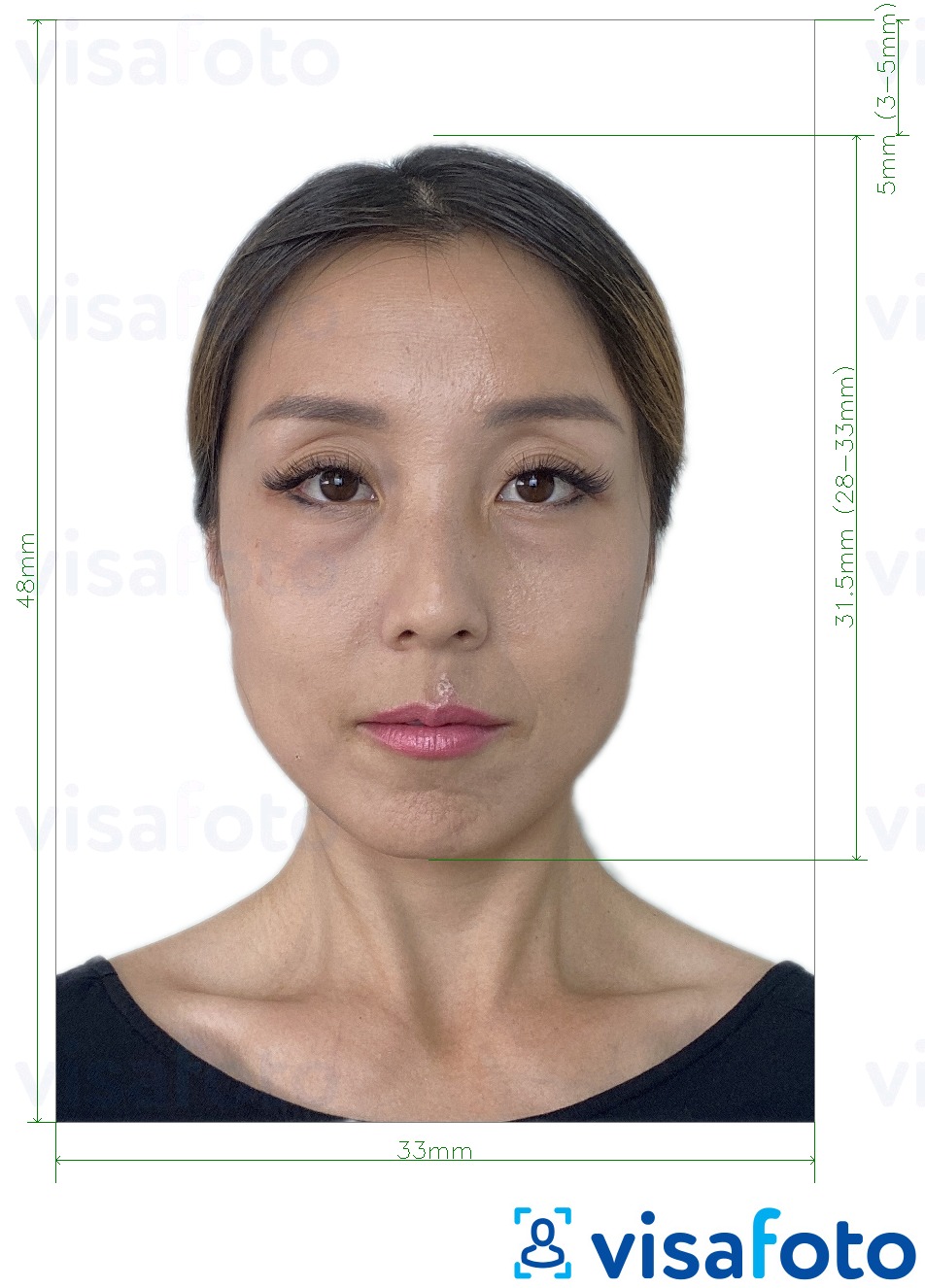
Get your China visa photo online for applications in India
As mentioned above, Chinese visa photos have specific requirements you will need to fulfil. To avoid problems with your application, you might want to trust professionals to ensure your photo is fully compliant with the parameters.
With Visafoto, not only will you get a single digital photo, but you will also get a template ready for printing. The photo you get from Visafoto will fulfil all requirements like background and face proportion, as well as correct subtler things such as contrast, head tilt, and eye position.
Source

Result

Simply take a picture of yourself with any background with decent lighting and follow all dress codes and posing rules. We recommend you dress in smart casual attire with no bright makeup or accessories.
Take an image with a smartphone or camera against any background, upload it here and instantly get a professional photo for your visa, passport, or ID.
First, take a photo under light like this one:

You will receive two versions of the photo: digital for electronic filing, and a printable template.
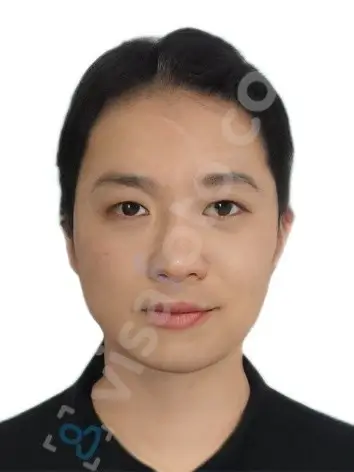
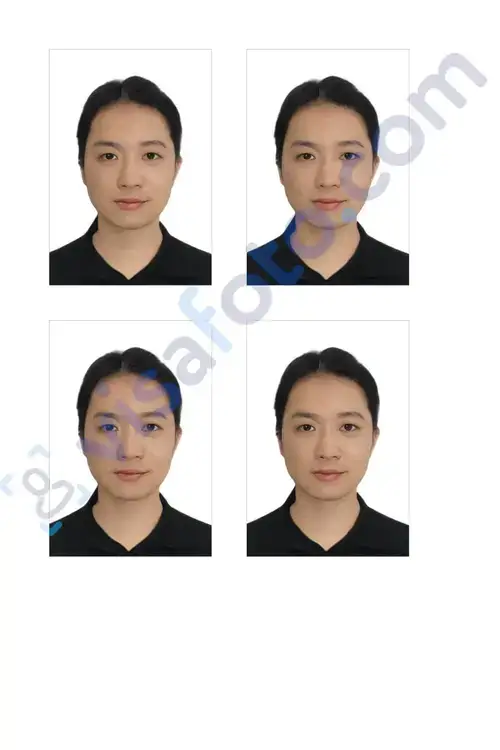
China Visa Photo App
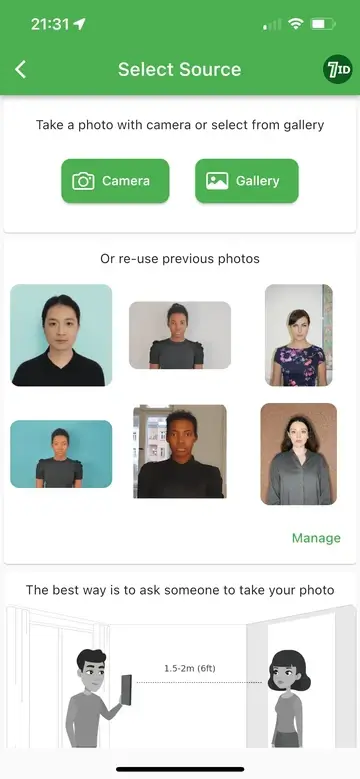

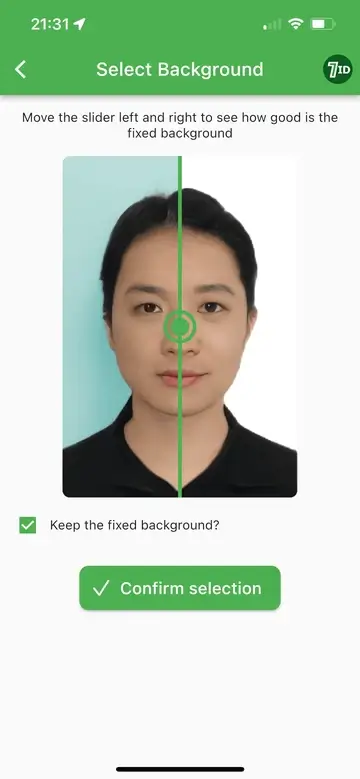
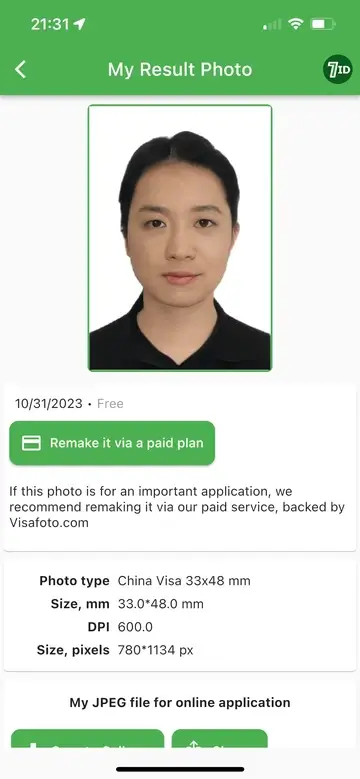
Looking for a simple way to prepare your China visa photo at home? The 7ID mobile app makes it possible. Instead of visiting a studio, you can snap a picture on your iPhone or Android and let the app handle the rest.
All you need to do is upload your photo and select the document type and country. The system automatically formats your picture to official standards—adjusting head size, position, and alignment for guaranteed compliance.
Even if your original background is unsuitable, 7ID refines it to the correct color and quality. With round-the-clock customer support, you can get quick assistance anytime you have a question or need extra guidance.
Submitting your Chinese visa application in India
Once you’ve gathered all required documents, submit them and pay the visa fee at your nearest Chinese Embassy or Consulate in India. Please note that most applications are handled via the Visa Application Service Centers (CVASC), not directly at the embassies.
Chinese Visa Application Service Center (CVASC) locations:
- New Delhi (CVASC):
Concourse Floor, Baba Kharak Singh Marg, Shivaji Stadium Metro Station, Connaught Place, New Delhi – 110001
Tel: +91-99990 36735 (Weekdays only)
Note: Apply here if you are in the jurisdiction of the Embassy in New Delhi :contentReference[oaicite:1]{index=1}. - Kolkata (CVASC):
BIPI Building Omega, Ground Floor, Bengal Intelligent Park, Block EP & GP, Sector V, Bidhan Nagar, Kolkata – 700091 (approx.) :contentReference[oaicite:2]{index=2}. - Mumbai (CVASC):
8th Floor, Mafatlal Centre, Nariman Point, Mumbai – 400021
Tel: +91-22-22855271 (Weekdays only) :contentReference[oaicite:3]{index=3}.
Embassy and Consulate Addresses (for special cases):
- Chinese Embassy in New Delhi:
50-D, Shantipath, Chanakyapuri, New Delhi – 110021 :contentReference[oaicite:4]{index=4}. - Chinese Consulate General in Kolkata:
EC-72, Sector I, Salt Lake City, Kolkata – 700064 :contentReference[oaicite:5]{index=5}. - Chinese Consulate General in Mumbai:
9th Floor, Hoechst House, 193 Backbay Reclamation, Nariman Point, Mumbai – 400021 :contentReference[oaicite:6]{index=6}.
Most visa applications—including document submission and fee payment—should be routed through the CVASC in your region. Applications directly to the embassy or consulate are typically reserved for diplomatic passports, media personnel, and related exceptions. Always check the official guidelines and opening hours in advance.
China visa fees for Indian citizens
The Chinese Embassy in India has extended the reduced visa fee rates through December 31, 2025. This initiative—originally introduced in 2024—is part of Beijing’s efforts to make travel more affordable for Indian visitors and encourage tourism and business engagement.
- Single-entry visa: ₹2,900
- Double-entry visa: ₹4,400
- Six-month multiple-entry visa: ₹5,900
- 12-month (or longer) multiple-entry visa: ₹8,800
- Group visa (per applicant): ₹1,800
Note: The express (expedited) service fee remains unchanged at ₹1,800 on top of the visa fee, if you opt for faster processing.
Last update: August 2025